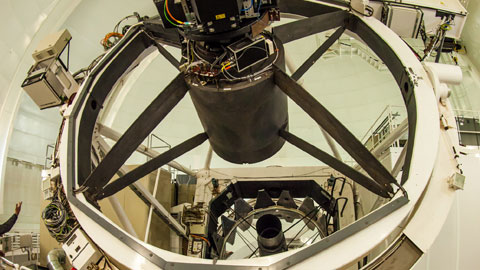First light for PAU camera, designed to study dark energy

08/06/2015
The camera was installed successfully to the William Herschel telescope at the Observatorio del Roque de los Muchachos (ORM) on the island of La Palma on 3 June. it received its first rays of light that same night and today its start-up phase ended. The tool is especially designed to measure with precision the distance between galaxies and thus study how the Universe expands at an ever quicker pace thanks to the influence of a mysterious dark energy which makes up 70% of space.
An Innovative Technology
The complexity of the PAU camera and the need to install it onto the primary focus of the Herschel telescope has contributed to the development of a revolutionary carbon fibre structure built in Spain. The PAUcam is the only camera of these dimensions in the world built with a carbon fibre structure.
Another of the camera's innovation is related to the technique used to measure the distance to galaxies. Since light travels at a constant speed, distant objects detected by PAU are observations made on the state of the Universe billions of years ago. In addition, given the fact that the Universe is expanding, these objects are even further away from us and, therefore, the light we observe tends to be red; similar to what happens when the siren of an ambulance travels away from us. This “redshift” is measured with photometric techniques by photographing the same object several times using different coloured filters. The PAUcam includes 40 different filters, and not the regular 4-6, therefore providing unprecedented precision when measuring “redshifts”.
“The camera allows conducting ample and precise studies of the expansion of the Universe” – says Cristóbal Padilla, researcher at the IFAE – “Thanks to the 40 filters incorporated and its large field of vision, in one night the camera can simultaneously capture the low resolution spectrum of some 50,000 objects. The PAUcam is not only a pioneer tool because of this measuring technique; it also includes innovations in other technological aspects belonging to these types of instruments”.
The PAUcam was designed and built in six years by a consortium of institutions which includes the Institute for High Energy Physics (IFAE), the Institute of Space Sciences (ICE-CSIC/IEEC), the Scientific Information Centre (PIC) - all three of which can be found at the campus of the Universitat Autònoma de Barcelona- and the Centre for Research in Energy, Environment and Technology (CIEMAT) and the Institute of Theoretical Physics (IFT-UAM/CSIC).
Expectations and Future Objectives
Now that the camera has been set up and used, it will be available for the research community interested in astronomical and cosmological measurements.
“The idea of building a tool such as the PAUCam, capable of providing important measurements for cosmology, began in 2007 within the context of the Consolider Ingenio 2010 project by the Ministry for Economy and Competitiveness(MINECO). The programme's objective was to conduct highly innovative projects in Spain. The team currently working with PAU, which will incorporate other European groups, has an ambitious programme to explore the scientific capacities of the camera”, comments Enrique Fernández, UAB professor and member of the IFAE, who was also former coordinator of the Consolider PAU project.
According to Francisco Castander, researcher at the ICE-CSIC/IEEC, “the international community is dedicating many resources to studying the origin and evolution of the Universe and the PAU camera represents a step forward in this process providing a new technique in measuring the structure and expansion of the Cosmos. In addition, data collected by PAU will provide valuable information for future space missions such as the Euclid satellite of the European Space Agency (ESA)."
The PAUcam is capable of measuring distances with a relative error of up to 0.3% in a large quantity of distant galaxies. That gives way to the possibility of reconstructing ancient cosmic maps (even from before the existence of Earth) and will help to calibrate and refine new observation techniques. It will also permit classifying tens of thousands of stars from our galaxy and from neighbouring galaxies in one single night.